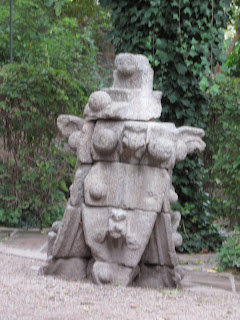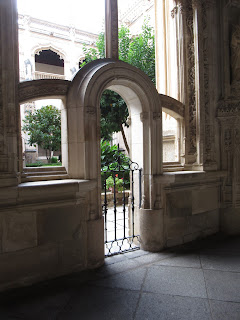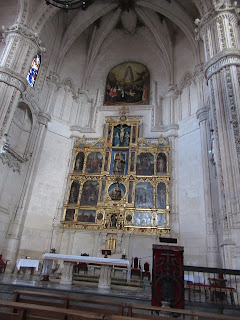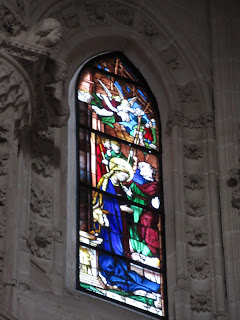Earlier in the day we'd taken the train from Madrid, Spain's current capital to Toledo, the country's previous capital and current regional capital, and toured the magnificent cathedral and dazzling tapestries. I was more curious than Steven to visit the Visigoth Museum in the former San Roman Church so he waited outside. The museum would have been more interesting and informative if there had been any information in English but it was, at least, attractive.
These cellars or vaulted galleries, the only part to survive from the original palace, were a legacy of the medieval Jewish quarter.
The church's High Altar was similar in style to many other Spanish churches with arresting paintings.
I swear there were churches and small plazas at every turn we took while strolling along Toledo's old town streets!
The Old Convent of Mother of God was now part of the Faculty of Science and Legal Justice at the University of Toledo.
The attractive Plaza de Marron or oddly named Brown Square:
We'd been forewarned on travel forums that the only sight at the Iglesia de Santo Tome was a painting by El Greco called The Burial of the Count of Orgaz. The church, founded on the site of an old mosque after the Moors had been defeated in the middle of the 12th century, was rebuilt with additions in later centuries.
Widely considered among his finest works, it illustrated a popular local legend of El Greco's era. I read that it is regarded as one of the three masterpieces of composition along with The Nightwatch in Amsterdam and Velasquez' Las Meninas in the Prado in Madrid. Many of the faces in the painting were painted in the likeness of famous historic people. The painting was a marvelous work of art, especially as its colors were still so vibrant after so many years and was well worth the price of admission. I was especially fortunate being able to see it without hordes of people standing in front of it which is normally the case.
We walked next to the El Greco Museum as the artist made his home in Toledo's Jewish Quarter in 1577 after leaving his native Crete in Greece. El Greco remained in Toledo for the rest of his career until his death in 1614. The museum was built on the foundations of a 16th-century Renaissance palace that belonged to a prominent member of the Jewish community in the 14th century before becoming the artist's home and studio.
These cellars or vaulted galleries, the only part to survive from the original palace, were a legacy of the medieval Jewish quarter.
The traditional patio or inner courtyard was decorated with magnificent plaster work and Renaissance earthenware jars as would have been the custom in the 16th century.
The Family of El Greco was painted by his son, Jorge Manuel, and it was thought that the painting was not only an attempt to create a perfect family portrait, but also to portray the idea of a perfect wife as perceived in those days.
Many of El Greco’s paintings are of a religious nature, as was the style in his day. His monumental work was of Jesus and the Twelve Apostles with their expressive faces.
In his Christ the Savior, Christ was depicted facing the viewer just like in ancient icons, offering his blessing and holding the globe with his left hand.
A museum handout described The Tears of Peter acknowledging his guilt and begging to be forgiven for having denied Christ three times. The theme of personal repentance and forgiveness was very common in the late 16th century, but El Greco was the first artist to show St. Peter on his own with his eyes welling up with tears and encouraging those seeing it to follow his upward gaze. The work was intended for private chapels as a devotional painting.
The painting by El Greco of his friend, Antonio de Covarrubias y Leiva, showed the well-known judge who helped him enter Toledo's intellectual circles.
El Greco's View and Plan of Toledo was of particular relevance because this type of composition had been unheard of in Spain. His depiction of the the city's Alcazar or Moorish Palace, and the Hospital de Tavera, the most important modern buildings of the time, showed the grandeur of the Imperial City.
Luis Tristan, a Toledan painter and apprentice of El Greco's, painted Christ Crucified, a key issue in the Catholic religion, with the most significant paintings on the subject created by El Greco. This was one of many paintings by Tristan at the museum.
I think my favorite piece in the museum was The Altarpiece of St. Bernardine, a commission from the church of the same name. El Greco was responsible for the altarpiece's simple, classic line but carpenters, joiners, gilders and other painters also helped to construct it.
I felt the museum gave us an appreciation of the uniqueness of El Greco's style that must have been quite controversial in that period. To be able to walk around this recreation of what El Greco’s home would have been like was amazing. The museum was in a magically beautiful setting with flower-rich gardens and two buildings with architectural wonders.
On the grounds of the museum was El Greco's grave.
From the museum, we could admire the attractive homes overlooking the river.
The El Transito Synagogue and Sephardic Museum was a reminder of the Jewish community that was expelled from Spain in 1492. Since then, it didn't function as a synagogue but as a church. Nowadays, while Jews from Madrid come to pray on Jewish holidays, the synagogue is mainly a museum of Jewish culture. Jews arrived in what became Spain during the first centuries of the Roman Empire because of the wars waged against them in Palestine. Jews achieved a status similar to that of other citizens in the empire due to an edict being passed in 303 AD. From the earliest days of their arrival, they could practice their religion without issues. Jews participated in the economic growth of the cities during the first centuries.
The synagogue still had intact architecture, from the days of Samuel Levi, treasurer to King Peter, in 1336. The place of worship felt very peaceful and was gorgeous with spectacular decorations and carvings.
The Torah or Scroll of the Law was adorned with a crown and breastplate.
Out back were Jewish tombstones from medieval Spain. Inscriptions included the name of the deceased, the day, date and year following the Jewish calendar and sometimes the cause of death. Some included liturgical expressions with Biblical passages.
Particularly impressive were the moving verses of prayer in Hebrew on the wall:
These are old tombs from ancient times
Where some men lie in their eternal rest.
Inside there is no hate, no envy
No love, no neighbors' hostility.
On seeing them, my mind cannot
Distinguish between masters and slaves.
This prenuptial agreement or Ketubah set out a husband's duties to his wife.
The 16th-17th century cup rest from Toledo had the coat of arms of the Inquisition, the court that mainly persecuted forced religious converts.
The silver Scroll or Megillah of Esther recounted the story of the Feast of Deliverance, known as Purim.
The exhibits were good, but the synagogue must be more than a little sad for Jews as the Jewish community in Toledo was once such a vibrant community, and now there is none. However, it was important that it was maintained for visitors to see and learn what had existed there.
Throughout the Jewish Quarter were small tiles with Hebrew letters at the bottom of buildings.
The Synagogue of Santa Maria la Blanca or St. Mary the White, originally known as the Ibn Shushan Synagogue, was erected in 1180 according to an inscription on a roof beam. It was constructed during the early Christian era by Islamic architects for Jewish use and is considered a symbol of the cooperation that existed among the Jewish, Christian and Moorish cultures that populated Toledo during the Middle Ages. The oldest, still standing synagogue in Europe became a church in the early 1400's and was used as a stable for Napoleon's troops in the 1800s. We chose not to enter having just toured the other synagogue and because there was more we still wanted to see in Toledo before returning to Madrid.
One sight was the late 15th-century Franciscan Monastery of San Juan de los Reyes that Queen Isabella, a famous Catholic monarch had built in commemoration of the victory of the Battle of Toro, and because the monarchs had also planned for Toledo to be their final resting place. The monastery's name of St. John the King referred to John the Evangelist.
It was still a living monastery unlike so many others we'd seen recently. The friars were dedicated to living out their lives in the monastery while adhering to vows of obedience, chastity and poverty with little contact with the outside world unless they sometimes teach and care for the sick. Their habit or clothing is a long brown tunic with a white cord tied around their waists with three knots symbolizing their vows.
The Cloisters were considered as a continuation of the church and for the celebration of liturgical processions.
The garden was a quiet place for reflection and followed the Roman design for homes, i.e. with a courtyard. It was intended to represent the Garden of Eden.
On the cloisters' upper level were many, many gargoyles, some quite frightening! I was glad we didn't have young children with us.
The Lower Cloister, completed in 1504, had carvings of many more female saints than male. The pillars were carved with floral and animal motifs.
The Upper Cloister was reserved for royalty. All the adjacent rooms were only for use by the Spanish monarchs. The only surviving room now is the Library which was used for the assembly of the Royal Court of Castile. The coffered ceiling and all the gargoyles were recreated at the end of the 19th century.
The church's High Altar was similar in style to many other Spanish churches with arresting paintings.
At the top was a painting of the Immaculate Conception, centuries before it became dogma in the Catholic church.
Above the altar was an unusual octagonal-shaped dome under which the monarchs had planned to be buried.
For some reason, almost all the windows were bricked up, except for two appealing stained-glass ones. Venerable Christian saints were carved on the walls.
In many Spanish churches we'd seen carvings of eagles; they were the symbol of St. John the Evangelist for some reason.
In many ways, Steven and I agreed we preferred the relative simplicity of the monastery to the grandiosity of the Toledo Cathedral we'd seen earlier in the day and was the subject of the previous post. The monastery's cloisters were gorgeous and the church felt more like a church intended for prayer than the cathedral with its hordes of tourists and noisy tour groups where quiet reflection was impossible.
At the base of the monastery, a tile depicted a menorah used in the Jewish Festival of Lights, even though we were no longer in the Jewish quarter.
As we walked back down and down toward the train station, it was interesting to see how cars managed to inch their way along down the narrow winding lanes!
The stone arch Alcantara Bridge rested on two round arches and was built over the Tagus River between 104 AD and 106 AD by an order of the Roman emperor Trajan. Over the ensuing centuries it had been badly damaged and repaired on a number of occasions but was largely destroyed in 1836. It was rebuilt in 1860 using mortared masonry and the main pillars were completely repaired in 1969.
The views from the bridge of the river and the city were ones I hope to never forget as they were so very pretty.
Our last view of the handsome Neo-Moorish train station I described in the last post:
We were so glad we'd spent the day exploring hilly Toledo, a city with an intriguing history, striking cathedral, and beyond gorgeous tapestries, in addition to two former synagogues, the fascinating El Greco Museum and living monastery, set overlooking the beautiful Tagus River.
Were you curious about the origins of the phrase 'Holy Toledo?' I was and discovered that when Alfonso VI of Castile kicked the Moors out of Toledo in 1085, the city became one of the great centers of Christian culture. Hence the nickname 'Holy Toledo.' It has since evolved into an exclamation exhibiting surprise, probably due to original surprise that a Moor-encrusted place could become holy!
Next post: Madrid's Enchanting Sorolla Museum.
Posted on January 15th, 2019, from suburban Denver.























































































No comments:
Post a Comment